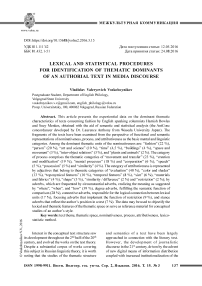Lexical and statistical procedures for identification of thematic dominants of an authorial text in media discourse
Автор: Voskoboynikov Vladislav Valeryevich
Журнал: Вестник Волгоградского государственного университета. Серия 2: Языкознание @jvolsu-linguistics
Рубрика: Межкультурная коммуникация и сопоставительное изучение языков
Статья в выпуске: 3 т.15, 2016 года.
Бесплатный доступ
This article presents the experiential data on the dominant thematic characteristics of texts concerning fashion by English speaking columnists Hamish Bowles and Suzy Menkes, obtained with the aid of semantic and statistical analysis (the AntConc concordancer developed by Dr. Laurence Anthony from Waseda University Japan). The fragments of the texts have been examined from the perspective of functional and semantic representations of nominativeness, process, and attributiveness as the basic mental and linguistic categories. Among the dominant thematic units of the nominativeness are: “fashion” (22 %), “person” (20 %), “art and science” (10 %), “time” (4,5 %), “buildings” (4 %), “space and movement” (3 %), “inter-object relations” (3 %), and “plants and animals” (2 %). The category of process comprises the thematic categories of “movement and transfer” (23 %), “creation and modification” (19 %), “mental processes” (18 %) and “cooperation” (6 %), “speech” (5 %), “possession” (5 %) and “similarity” (4 %). The category of attributiveness is represented by adjectives that belong to thematic categories of “evaluation” (40 %), “color and shades” (13 %), “toponymical features” (10 %), “temporal features” (8 %), “size” (6 %), “materials and fabrics” (4 %), “shape” (3 %), “similarity / difference” (2 %) and “restriction” (2 %); by adverbs, which are frequented by circumstantial adverbs, realizing the meaning as suggested by “where”, “when”, and “how” (39 %), degree adverbs, fulfilling the semantic function of comparison (28 %), connective adverbs, responsible for the logical connection between lexical units (17 %), focusing adverbs that implement the function of restriction (9 %), and stance adverbs that reflect the author’s position in a text (7 %). The data may be used to objectify the lexical and thematic features of the thematic space or serve as reference material for conceptual studies of an author’s style.
Text theme, thematic space, nominativeness, process, attributiveness, lexico- statistic method
Короткий адрес: https://sciup.org/14970296
IDR: 14970296 | DOI: 10.15688/jvolsu2.2016.3.15
Список литературы Lexical and statistical procedures for identification of thematic dominants of an authorial text in media discourse
- Xerox -Linguistic tools. Available at: https://open.xerox.com/Services/fst-nlp-tools.
- AntConc -AntConc Homepage. Available at: http://www.laurenceanthony.net/software.html.
- Belousov I.K. Strategii strukturirovaniya tematicheskogo prostranstva teksta . Vestnik Permskogo universiteta. Rossiyskaya i zarubezhnaya filologiya, 2014, no. 4, pp. 15-25.
- Buranova A.I. Tematicheskaya organizatsiya dialektnoy rechi: kvantitativnyi analiz . Izvestiya Saratovskogo universiteta. Seriya: Filologiya. Zhurnalistika, 2012, no. 3, pp. 35-38.
- Downing A., Locke Ph. English grammar: A University Course. Second Edition. Oxon, Routledge, 2006. 610 p.
- Moskalskaya O.I. Grammatika teksta . Moscow, Vysshaya shkola Publ., 1981. 183 p.
- Noskova O.A. Smysloporozhdayushchee prostranstvo teksta kak kharakteristika lingvokognitivnogo stilya avtora-publitsista . Vestnik Kemerovskogo gosudarstvennogo universiteta, 2012, vol. 4, no. 4 (52), pp. 80-84.
- Petrova N.Yu. Osobennosti publitsisticheskikh tekstov malogo formata: na materiale kratkikh zametok zhurnala “The New Yorker”: dis.. kand. filol. nauk . Moscow, 2005. 195 p.
- Bowles -Hamish Bowles -Vogue. Available at: http://www.vogue.com/contributor/hamish-bowles/.
- Menkes -Suzy Menkes -The New York Times. Available at: http://www.vogue.ru/suzy_menkes/.


